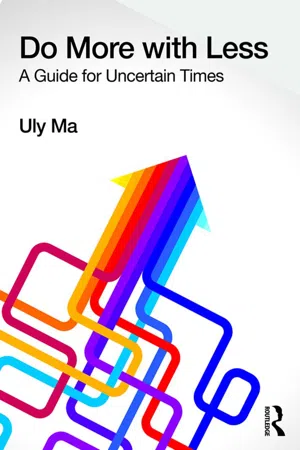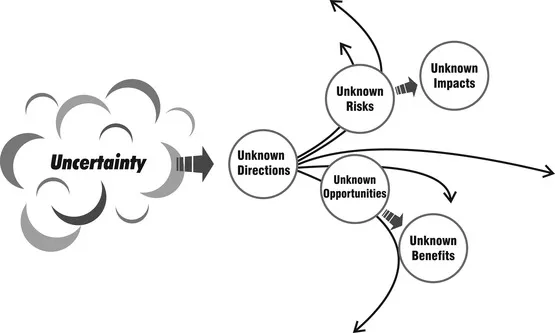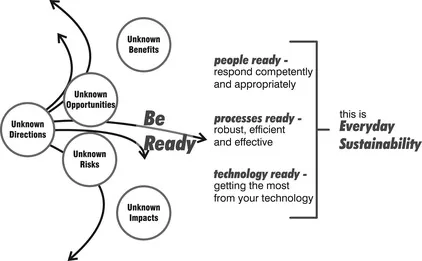1 Uncertainty, sustainability and waste
To start, let’s define a few terms I will be using throughout this book.
Uncertainty means situations where we are not sure of the outcome or things that are not known to us.
Sustainability, in a strict definition, means keeping things going. However, conventionally it can mean a whole host of things: using the right amount of resources to do the required job, protect the environment, plant trees, not print your emails and save the polar bears.
Everyday Sustainability is a term I coined to describe the activities we can do (every day) to keep our organisations going, to protect the environment through using the right amount of resources and to, well, save money from reducing waste – which both keep the organisation going and use the optimal amount of resources. The important thing about “doing Everyday Sustainability” is that it needs to be simple to do, easy to learn and practical enough to make sense to everyone.
Now, you may think I am going to have a hard time joining these themes into a rational and logical discussion, but no, it is not (too) difficult to bring these together. They join up because uncertainty means what were constants before are no longer there, and this can blow a hole in our sustainability plans. People then tend to overreact to uncertainty and throw money (and resources) at the problem and therefore blow another hole in sustainability. Then we suddenly realise that in conventional businesses, the sustainability function is a cost centre. Oops, another hole and the good ship, sustainability, is rapidly sinking in the sea of uncertainty.1
One way to deal with uncertainty is to take a fresh look at our world, our organisations and our activities – to see whether our existing concepts and approaches will work in the new and ever-changing environment. I therefore suggest we need to reassess our outlook and update our thinking to see every uncertainty as a possible opportunity.
So far, in 2017, every week brings news of some change in laws, in geopolitics and in business deals, and each of these changes comes with its own accompanying uncertainty. Uncertainty can mean a lot of things: unknown directions for our organisations and, with them, unknown opportunities and unknown risk, as shown in Figure 1.1.
But if you look beyond the headlines, then every opportunity will offer unknown benefits and every risk will offer unknown impacts. I would like to think that with a bit of effort, we can make sure we are ready – ready to take advantage of opportunities coming our way and equally ready to deal with risks in whatever direction our organisation takes. To do that, I suggest we make sure our people are ready to respond competently and in an appropriate way; our processes are robust, running efficiently and effectively; and we, as an organisation, can make the most from the technologies we deploy.
These three factors, I believe, make up Everyday Sustainability. This is sustainability both in its classical sense of continuing as well as the modern sense of using resources properly, as shown in Figure 1.2.
Figure 1.2 Everyday Sustainability.
However, before we start exploring Everyday Sustainability, we need to see how uncertainty affects our thinking about global economics and climate and how uncertainty shapes the world’s evolving actions on sustainability. To look at how uncertainty shaped the way we think and act, let’s examine one of the best everyday examples about uncertainty: our weather!
Bad weather
Daily weather forecasts show you a percentage likelihood of rain. In a place the size of London (around 1570 km2 or about 600 square miles), a 10 per cent chance of rain at 11:30 can mean 100 per cent in your part of London and no rain in other areas – see, weather is uncertain! To deal with that uncertainty means being ready: we carry umbrellas, raincoats or hats, or we get wet. Those of us of a certain age will remember the weather in the “old days” when London always seemed cool and damp the whole year. Now, we have climate change, and even the British weather isn’t what it used to be.
In early June 2016, I was taking a break from writing this book when I checked the news on the Internet – “Heavy rain, the Seine rose 5.5m and Paris is flooded.” Oops, I was going to Paris on holiday the following week! Then I remembered watching the news at the end of December 2015: masses of flood warnings in Northwest England. I also remembered doing a series of workshops in Dorset during February 2014 and wondering whether I would be able to get home because of the floods. The weather appears to be getting worse and more uncertain every year. Now, weather is serious business in Britain;2 the uncertainty means not only do we have more to talk about, we are also having our lives disrupted. Let’s face it, after you have been flooded out of your house three times in a decade because of a recurring “flood of the century,” you’d start believing something uncertain (and unpleasant) is happening in the atmosphere.
Climate and environmental scientists tell us that global climate change is occurring because we are burning too much fossil fuel, and the resulting greenhouse gases are trapping the heat from the sun. (Detractors claimed otherwise; now there’s uncertainty! Who do you believe?) The scientists claimed the result of climate change is more than just weird and unpleasant weather; it also contributes to crop failure and desertification of marginal land. With the prospect of polar ice cap melting, the impacts will include rising sea levels threatening low-lying islands and coastal regions; it also means that polar bears will be having a pretty hard time.
Now, there are all kinds of people who reckon this is a conspiracy by _______ (insert your favourite conspirators; the Internet will always be able to provide some degree of proof!), but actually whether it is climate change or the rain gods being unhappy with us, the reality is that people’s lives are being damaged and their livelihoods threatened. By people, I mean people like you and me. It may not have happened to you (or me) yet, but hey, it can threaten our social fabric, and it can make the lives of our children and grandchildren more miserable too.3 However, Greg Chant-Hall, an international expert on sustainability, suggests that people in different parts of society see sustainability as different things, and the different interpretations can contribute to uncertainty and lead to confused and mutually incomprehensible conversations. Groups are staking out different areas of society and confront each other with their own versions of the truth. Figure 1.3 uses the Triple Bottom Line sustainability model (described later in this chapter as well as in Chapter 3 and Appendix 2) to illustrate the divergence of views.
Figure 1.3 How Different Stakeholders Interpret Sustainability.
It is actually quite surprising that we have come this far with these very different views about what sustainability is. But joking aside, if we want our businesses to create wealth and jobs; if we want to see an end of human-generated species extinction; and if we want our society to be successful, then we need to take this seriously.
Countries and governments have been working on this for years, and in November 2015, 185 countries came together in Paris to agree to combat climate change, and the resulting Paris Agreement (also known as COP 21) brings the world’s countries towards a common cause. The central aim of the Paris Agreement is to address the threat of climate change by keeping global temperature rise to below 2°C from pre-industrial levels and furthermore, to pursue efforts to limit this rise to within 1.5°C.4 The 1.5°C aim is to protect low-lying areas and island nations, which are more under threat from rising ocean levels. By May 2016, 1775 countries signed the Paris Agreement, and by November 2016, it came into force. While this is good news to some, it is also anathema to others. President Trump announced that he will reduce the budget of the US Environmental Protection Agency, and people are now saying he doesn’t believe in sustainability.
So what has this got to do with Everyday Sustainability? These are all high level things that we as individuals do not seem to be able to have much influence over. Unfortunately, an underlying cause for these concerns, the subsequent activities and legislation is Climate Change, and its impacts are all too real and can affect our lives and our businesses.
Climate Change, formerly known as global warming,6 is a concern to the global community, as it not just impacts us next week when you are expecting a sunny holiday (like me) but also the way our organisations function. Thanks to globalisation, climate impacts can affect businesses around the world. I remember tracking the shipment of my newly purchased laptop only to find that it was stalled in the Far East because of a typhoon. In 2011, flooding in Thailand disrupted global supply of computer hard discs, and the 1995 and 2016 earthquakes in Japan disrupted just-in-time deliveries. We need to pay attention to climate change because it can affect our business activities, because our customers are concerned, because the media continually draw our attention and because our governments are putting in legislation to reduce the use of fossil fuels since citizens and media are concerned.
How did we get here?
To understand how Climate Change generated uncertainty and opportunities, we need to gain an understanding of the history of modern sustainability, also known variously as energy efficiency, environmental management, sustainability management or ecological management. The range of names gives us an indication of the possible opportunities for individuals and businesses to respond.
Modern concerns about Climate Change (or as it was called then, the Oil Crisis) started in 1973 when oil prices went from about US$0.80 a barrel to about US$3.00 a barrel. Uncertainty about the impacts of this (it was an abyss time, for sure) started a lot of actions that led to our current thinking on sustainability. That price rise set off major action in developed countries towards energy efficiency. The impetus in those early days was mainly on costs, rather than environmental protection. However, the focus has changed gradually. Figure 1.4 is my time line on the evolution of sustainability – it is not definitive or comprehensive, but it helps me understand how we got here.
Figure 1.4 A Sustainability Timeline.
The Brundtland Declaration document for the United Nations in 1987 was called “Our Common Future.” It is not a scintillating read, but it did establish the fact that we need to look after the world for future generations. This set the theme for sustainability as a real issue and framed its developmental pathways thereafter.
The Rio Earth Summit of 1992 established the principle that environmental protection should be a part of the development process.7 It is a logical step from the thinking from the Brundtland Declaration and brought sustainability into real activities, rather...




